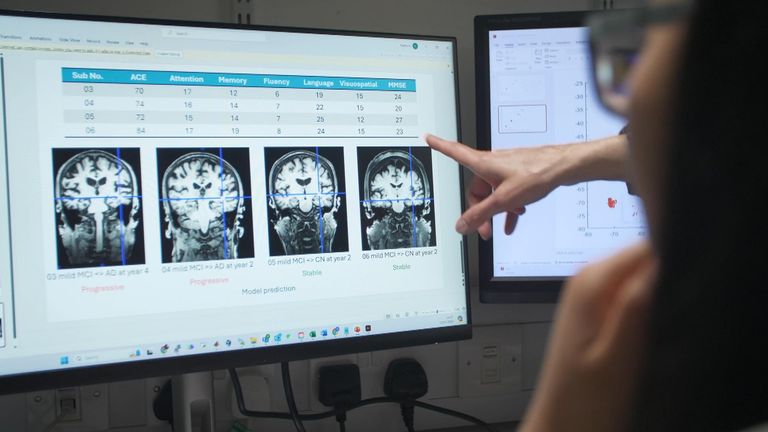After losing three babies in consecutive pregnancies, Pernille Burgdorf felt desperate.
"We had lost three sons who were healthy," the mother-of-two from Jutland, Denmark, told Newsweek. "The doctors couldn't find anything wrong with them."
Each baby had been born prematurely. "The first we lost in week 27; the second in week 17; and the third in week 23," Burgdorf said.
During each pregnancy, Burgdorf experienced severe vaginal discomfort. "I had this heavy discharge and constant itching and stinging," she said. "It was also very shameful for me."
Desperate for answers, Burgdorf and her husband investigated her symptoms online and found that they were consistent with the symptoms of bacterial vaginosis.
Bacterial vaginosis is an infection caused by changes in the billions of microbes that live in the vagina, known as the vaginal microbiome.
A healthy vaginal microbiome is typically dominated by Lactobacillus bacteria, which play an important role in protecting their host from infections and maintaining optimal conditions inside the vagina. However, due to a variety of factors—including antibiotics, "douching" and transmission from sexual partners—the vaginal microbiome can become imbalanced and overrun with "bad" bacteria, resulting in vaginosis.
According to the World Health Organization, more than 1 in 5 women experience vaginosis at some point in their lives, although as many as 50 percent of cases are asymptomatic. The condition has also been associated with a range of reproductive health issues, including lower chances of conceiving during IVF, an increased risk of healthy pregnancy loss, and preterm births.
"I asked [my doctors] if they could test me for bacterial vaginosis but they didn't see a reason to," Burgdorf said. "I felt like my doctors were telling me I was stupid."
In August 2021, Burgdorf went to the Recurrent Pregnancy Loss Clinic at Copenhagen's Hvidovre Hospital.
"When we first went [to the clinic] I felt like we had tried everything," Burgdorf said. "But both me and my husband decided to give it a go."
At the clinic, Burgdorf met Dr. Henriette Svarre Nielsen, a professor and gynecological consultant at the University of Copenhagen and head of the Recurrent Pregnancy Loss Clinic.
"We were actually in the middle of doing a larger randomized controlled trial to explore the benefits of transplanting vaginal microbes from healthy donors to treat vaginosis," Nielsen told Newsweek. "We had already screened 302 healthy women in the Copenhagen area and had a predefined protocol to make sure we were not transmitting any diseases.
"That was all ongoing when Pernille came into my clinic and told us her story."
Burgdorf was asked to give a vaginal sample for further testing and, six days later, received a phone call from the nurse. 90 percent of Burgdorf's sample was dominated by a bacterium called Gardnerella, a known culprit of bacterial vaginosis.
"For the first time ever, somebody was actually saying, 'You've been right all along,'" Burgdorf said. "They asked me if I wanted to be patient zero for their vaginal microbiome transplant. And for the first time I thought, 'I can find the answer, but I can also be an answer for so many other women and families who were losing their children.'"
After selecting a suitable donor, the team, led by then-PhD student Tine Wrønding, administered Burgdorf's vaginal microbiome transplant. They had been expecting to deliver several rounds of treatment before her symptoms went away. But this was not the case.
"The amazing thing was that, after a week, she called us and said she had no symptoms," Nielsen said.
Burgdorf added: "I don't think anyone could have hoped for a better result. But also I was so angry: 'Was this all I needed? We buried three boys and they died because of bacteria?'"
Five months later, Burgdorf became pregnant. "I had no symptoms at all," she said. "I just felt like a completely new woman."
However, within six weeks, the Gardnerella had come back. "We got so scared," said Nielsen.
The team hurried to collect a second vaginal sample from the donor and set up an appointment with Burgdorf. But to everyone's relief, on the day of the appointment, Burgdorf's microbiome had reverted itself back to its healthy post-transplant status.
"She actually had the power to convert it back by herself," Nielsen said.
Although it was a tense and stressful time, Burgdorf said the pregnancy went "perfectly" and she delivered a healthy baby boy.
It has now been 19 months since her "miracle" baby, Erik Mario, was born. "I have no doubt in my mind that it must have been [the transplant,]" Burgdorf said.
However, while Nielsen is "super excited" by these results, she cautioned that it is too early to say the transplantation alone was responsible for Burgdorf's pregnancy success.
"We need more data to confirm that," she said. "The only thing we can say with complete firmness is that her symptoms disappeared and that the [transplanted microbes] have persisted in her body. Still, it's mind-blowing that you can give a donor that engraft and that she is able to go on to menstruate, get pregnant, deliver her baby and still keep having that donor-originated Lactobacillus in the vagina. I think that's pretty amazing."
Nielsen added that, based on the results of the trial so far, the treatment does not work for everyone. "It's like everything else in medicine—some people will benefit, like Pernille, and that is amazing but there's so much more we need to learn before this can become a [standard] treatment," she said.
This treatment has not only shown promise in restoring fertility, but it may also offer symptom relief for women at the end of their reproductive years. "We know about all the problems that happen when estrogen goes down when you go into menopause, and there could be some benefits [of microbial transplantation] for the vaginal dryness and increase in infections and all of that," Nielsen said.
In the future, Nielsen hopes the treatment will become more scalable and accessible to patients. "I hope that in 10 years, they will have an artificial version [of vaginal microbiome transplants] because there are so many women needing this treatment," she said.
"I also think it's important to discuss that, in a transplantation like this, we get everything [from the donor's microbiome]—we get the ["good"] bacteria but we also get immune factors and a lot of other [beneficial] things together with those microbes. [By contrast,] if you take probiotics it's just one strain—maybe two strains—of bacteria that you are introducing. So that might explain why we have not seen such effective results with probiotics."
As for Burgdorf, she encourages anyone in a similar position to ask their doctors to test for bacterial vaginosis. "If you have a feeling that there is something wrong in your body, stick with it and believe in yourself," she said. "One test can make a huge difference, not just for the parents' lives but also for the small life you can end up losing."
A New Era of Treatment
Today, bacterial vaginosis is mostly treated using vaginally-administered antibiotics. However, while this treatment comes with an 80 to 90 percent cure rate, antibiotic treatment also comes with some major drawbacks.
For one, 60 percent of patients see a recurrence of symptoms within the first 12 months after treatment. Secondly, antibiotics may harm the balance of healthy bacteria in the vagina (or in the gut if administered orally.) Finally, the use of antibiotics may result in the development of antibiotic resistance among vaginosis-related bacteria, potentially making the condition even harder to treat.
Vaginal microbiome transplantation has been demonstrated once before in a study in 2019, in which five women with recurrent vaginosis were treated with vaginal microbiome transplants from healthy donors. However, the transplants were received after pretreatment with antibiotics and there was no proof of engraftment of the donor bacteria.
What is unique about Burgdorf's case is the fact that the transplant was performed in the absence of antibiotics, resulting in a long-lasting shift in the bacterial composition of the recipient's microbiome, including engraftment and persistence of the donor strains.
The full case study can be read in the journal EClinicalMedicine.
Is there a health problem that's worrying you? Let us know via health@newsweek.com. We can ask experts for advice, and your story could be featured on Newsweek.
Disclaimer: The copyright of this article belongs to the original author. Reposting this article is solely for the purpose of information dissemination and does not constitute any investment advice. If there is any infringement, please contact us immediately. We will make corrections or deletions as necessary. Thank you.



